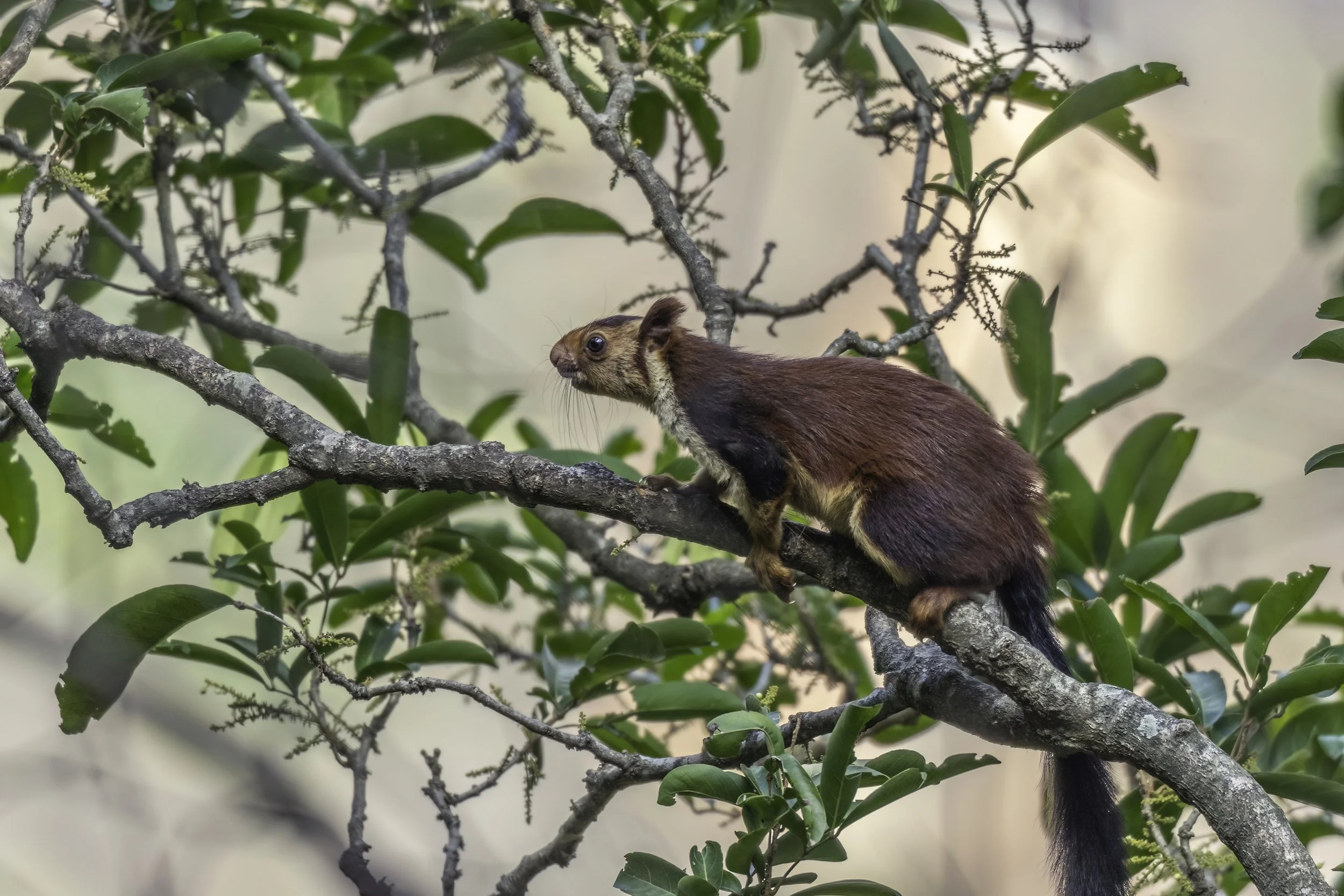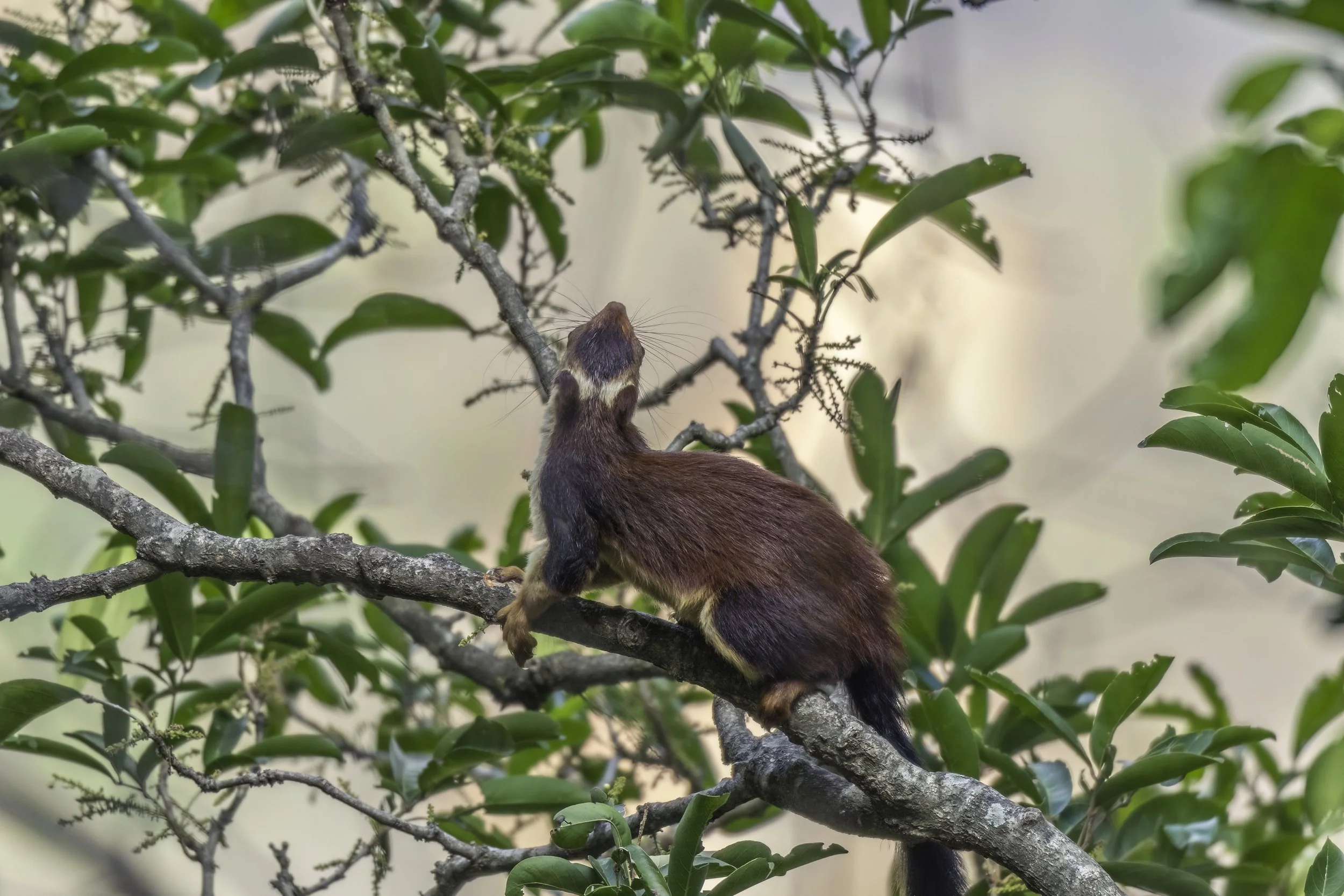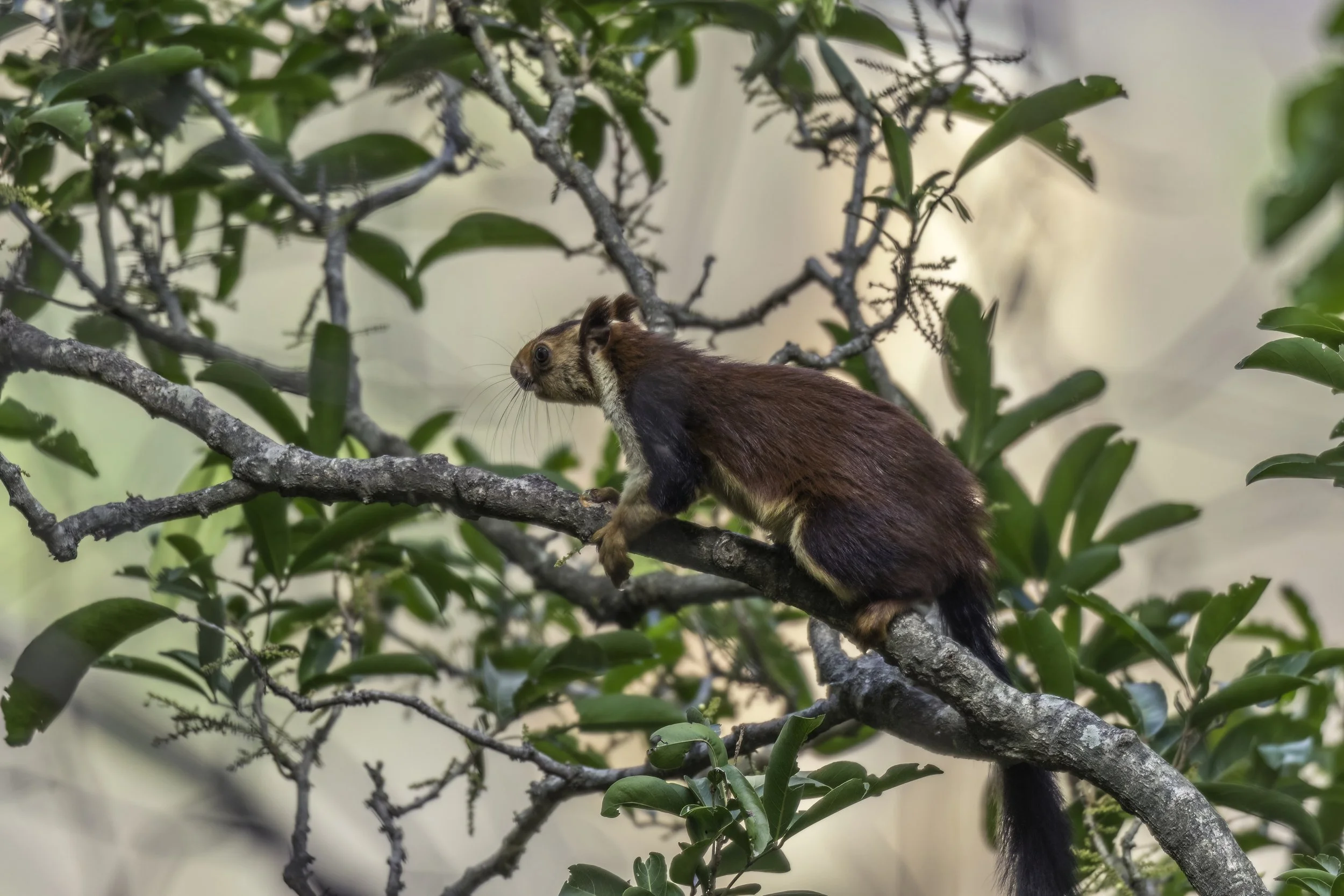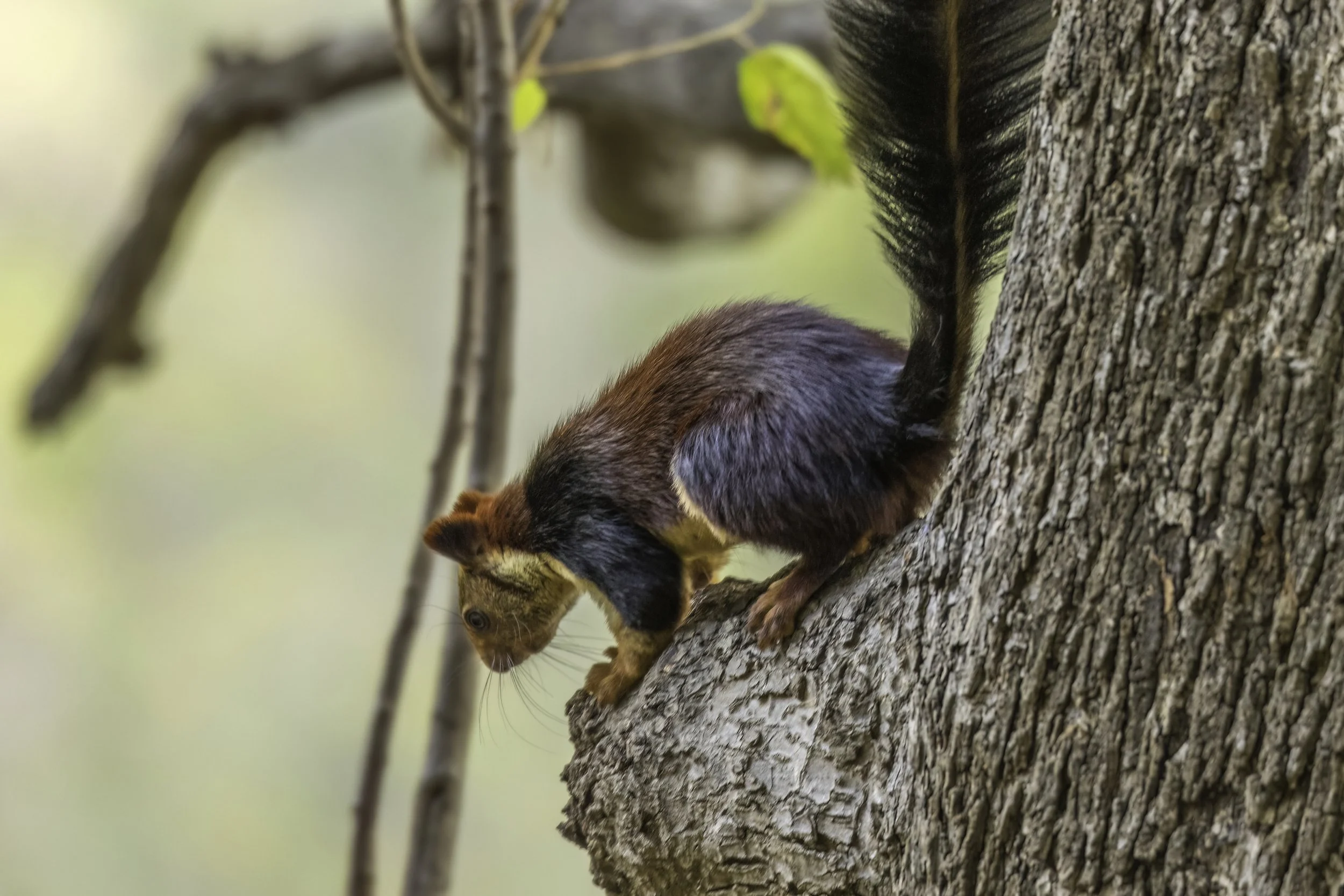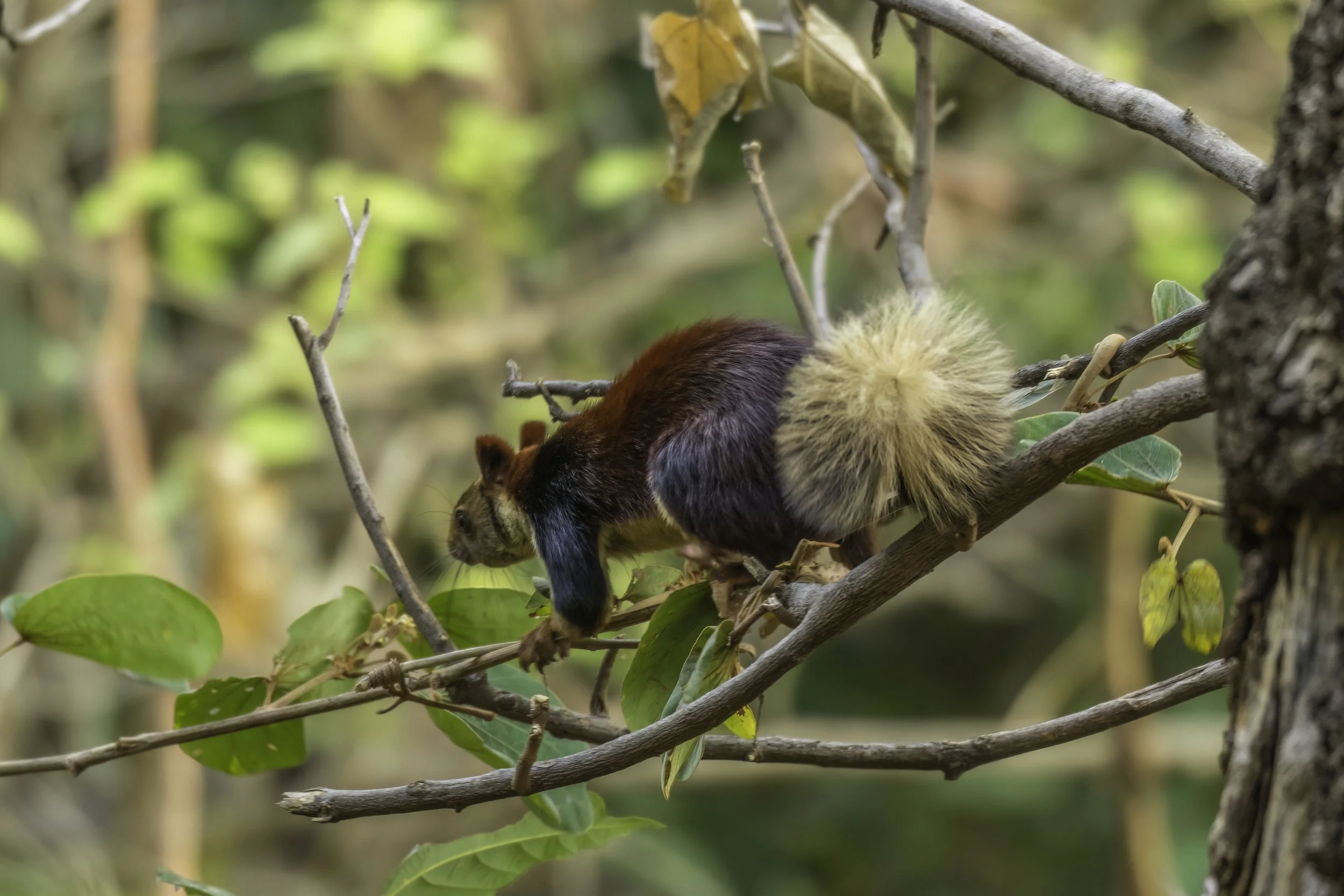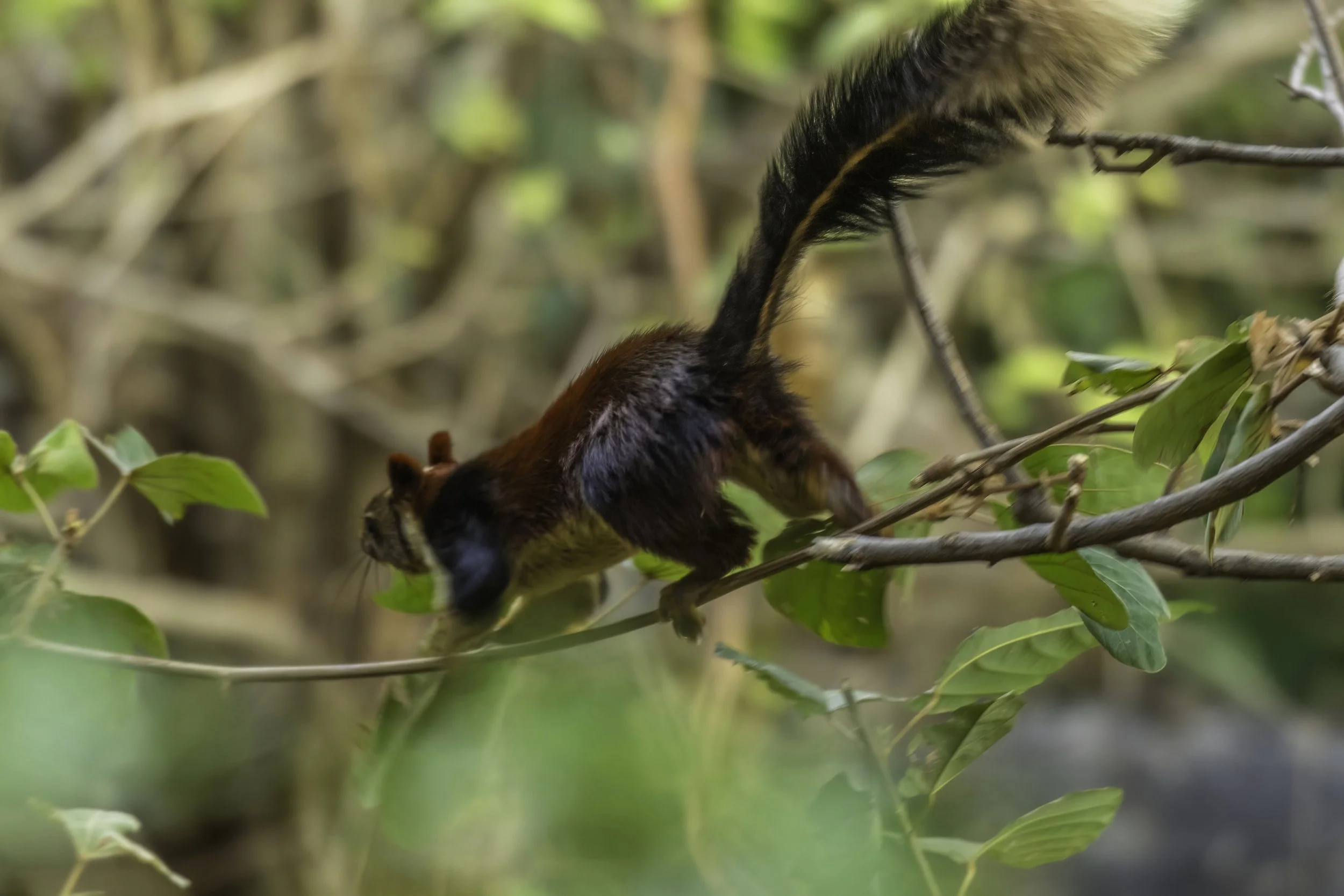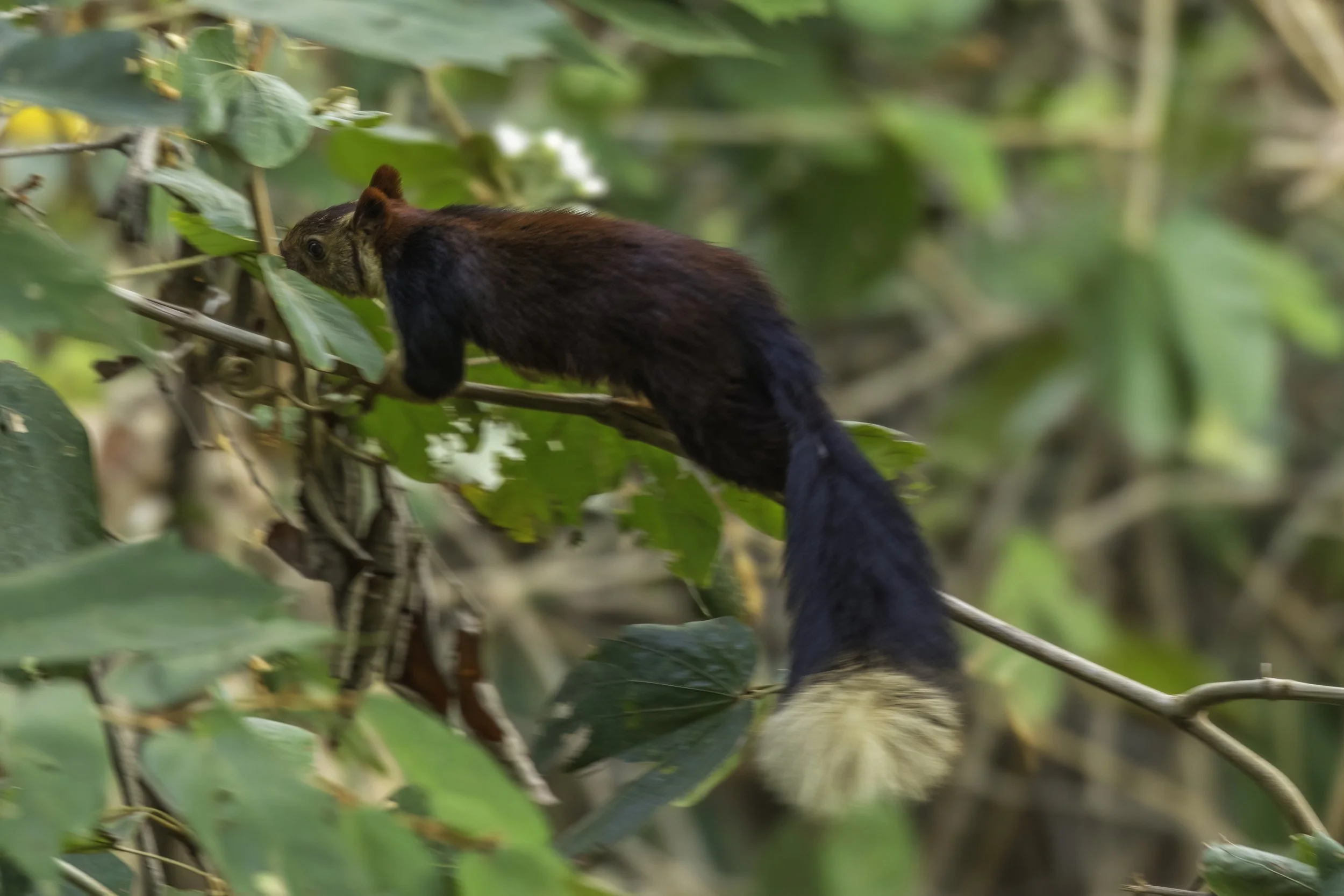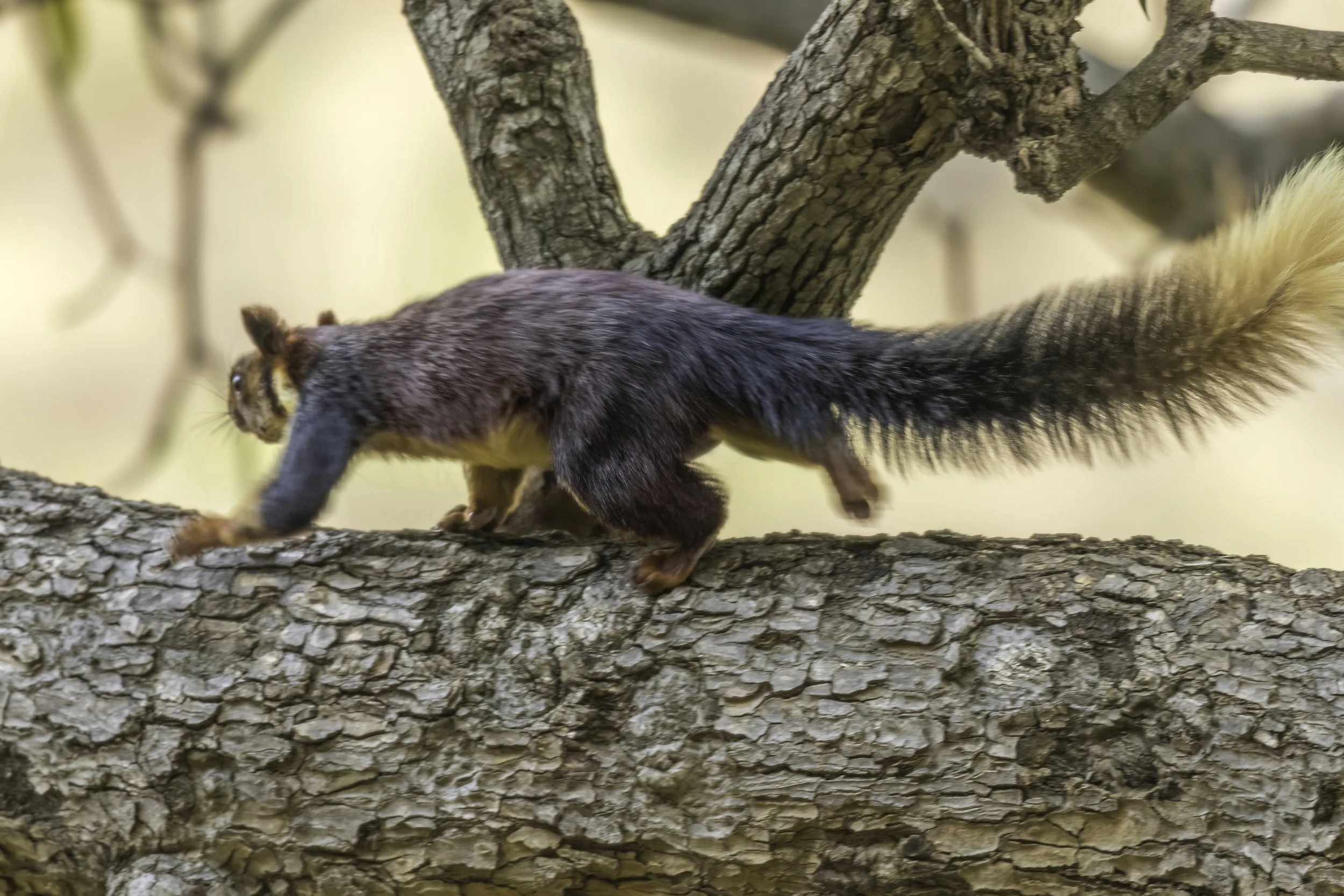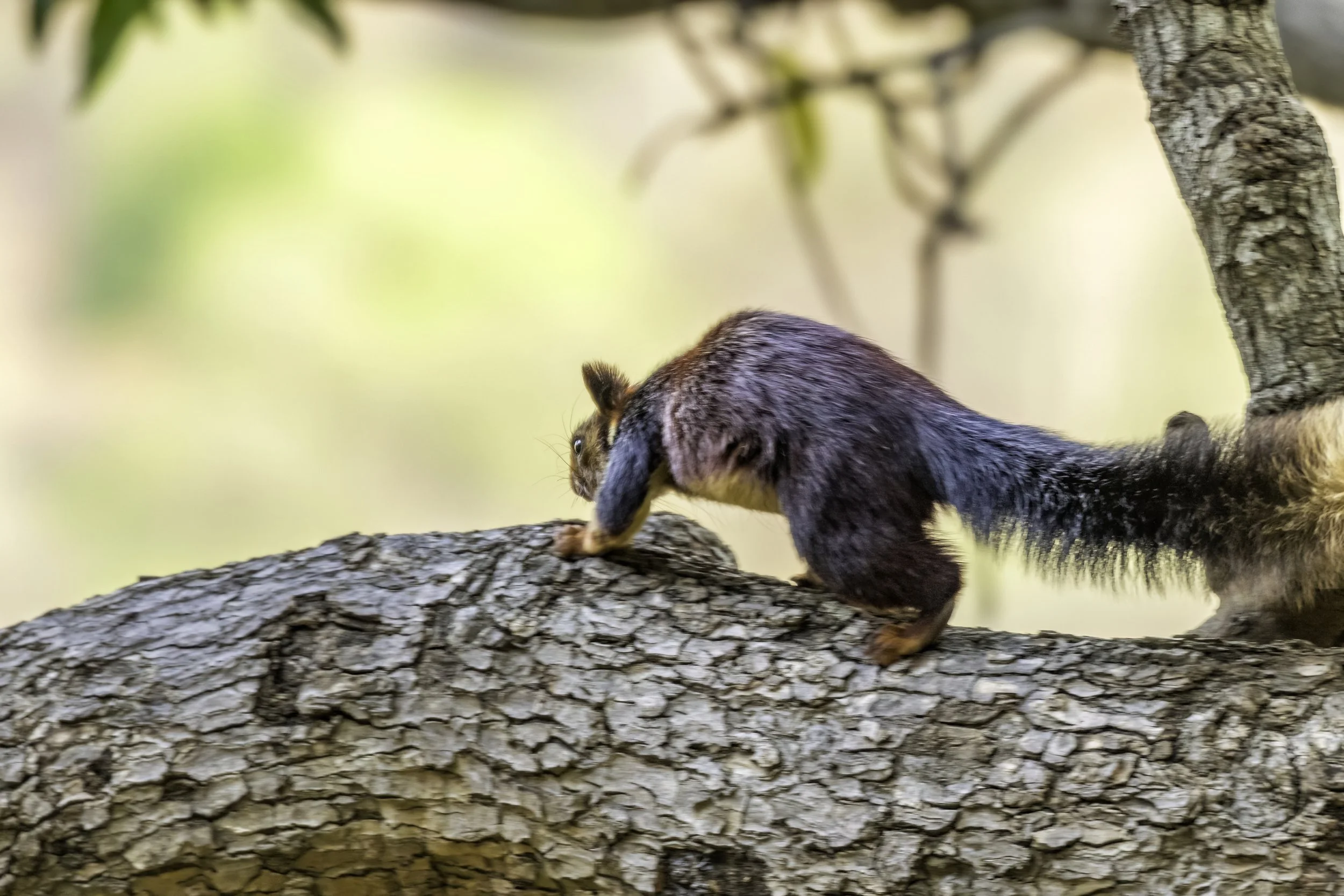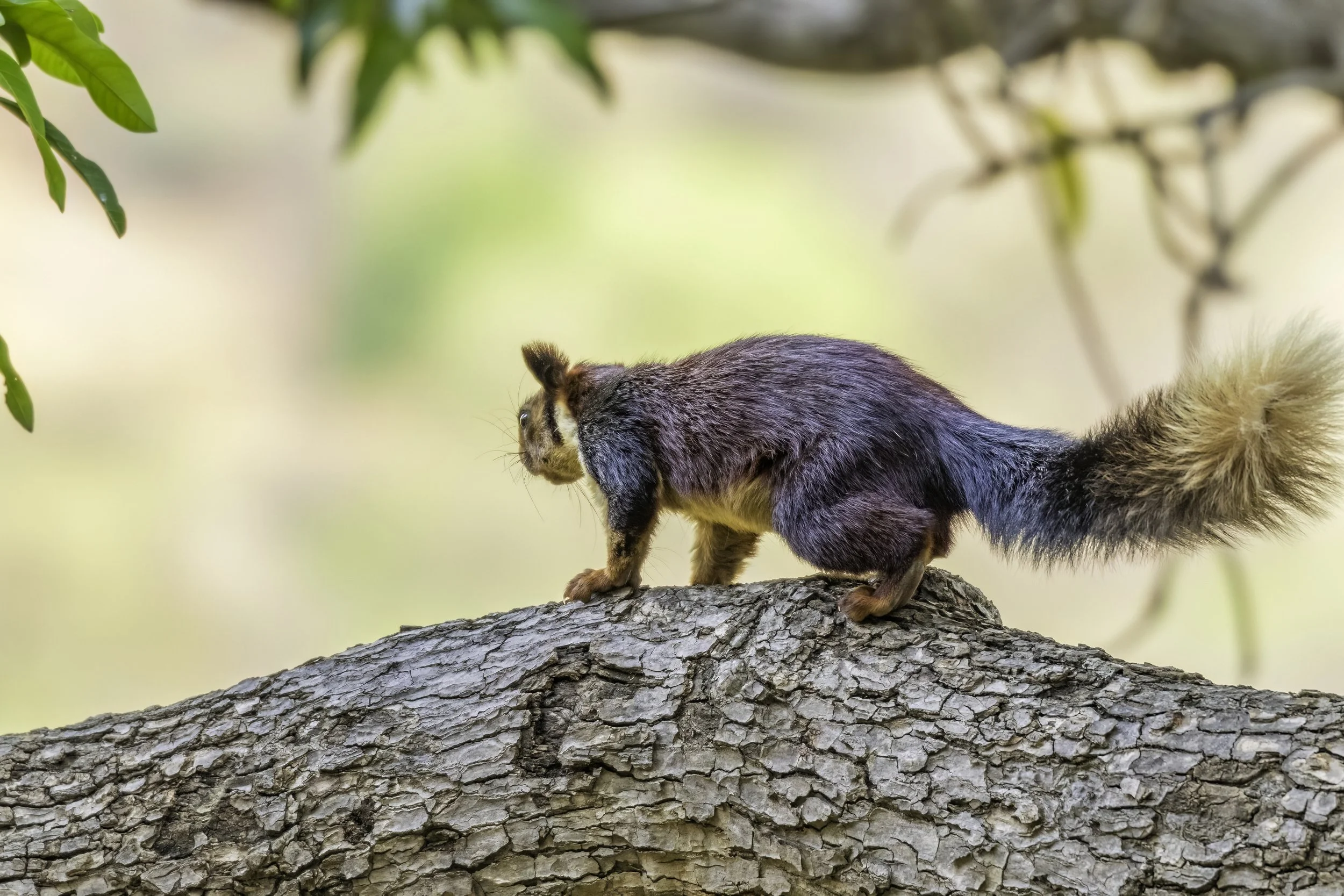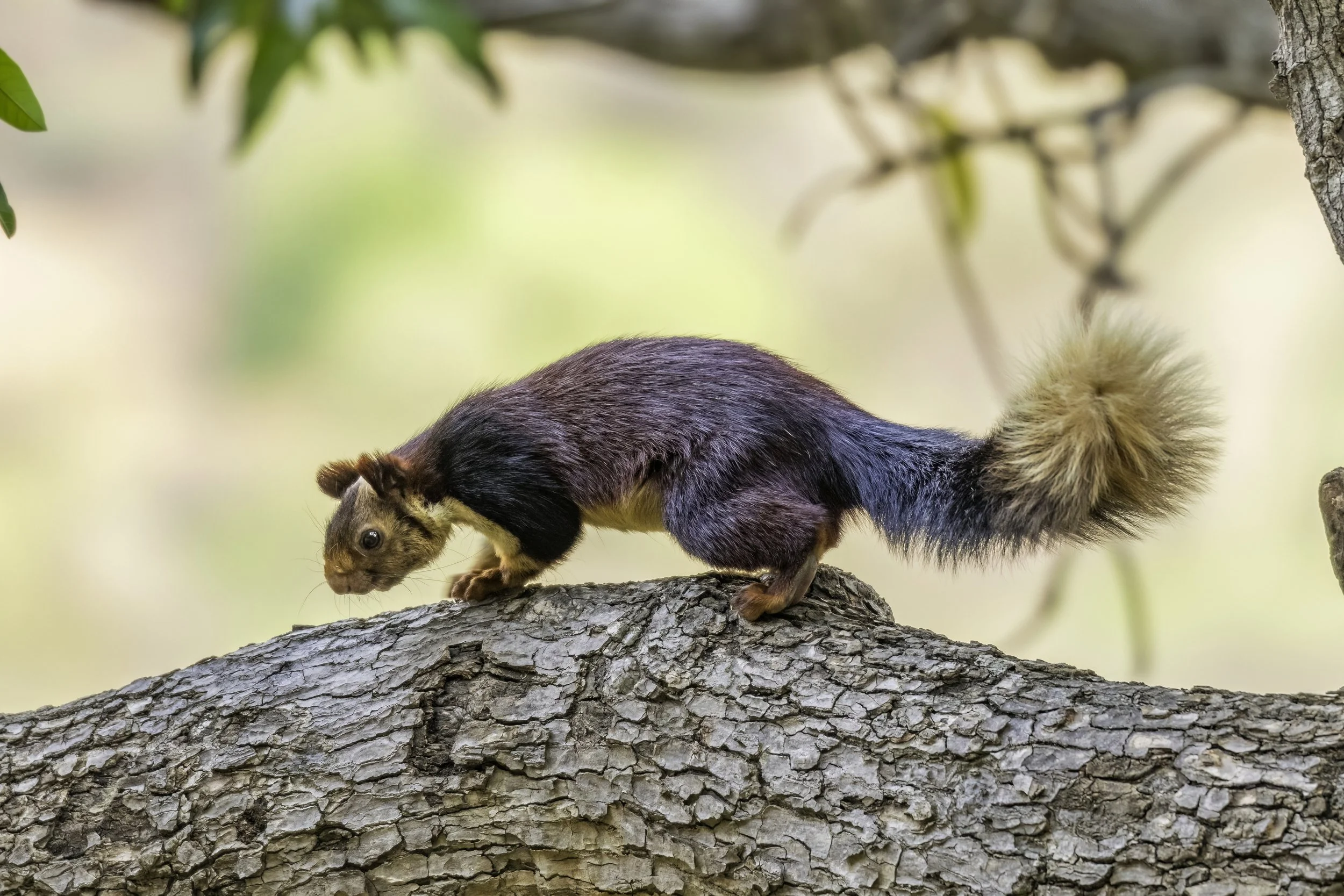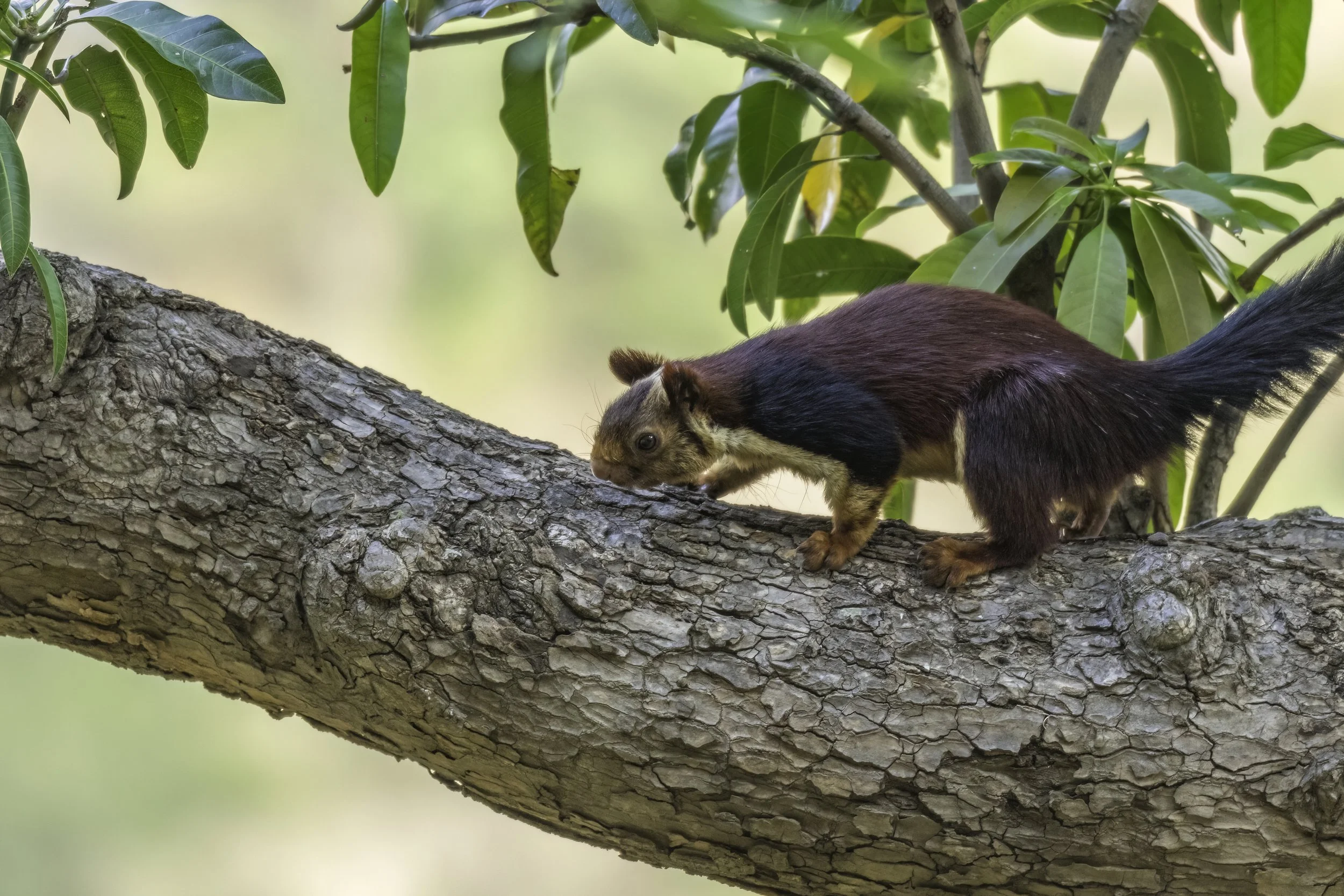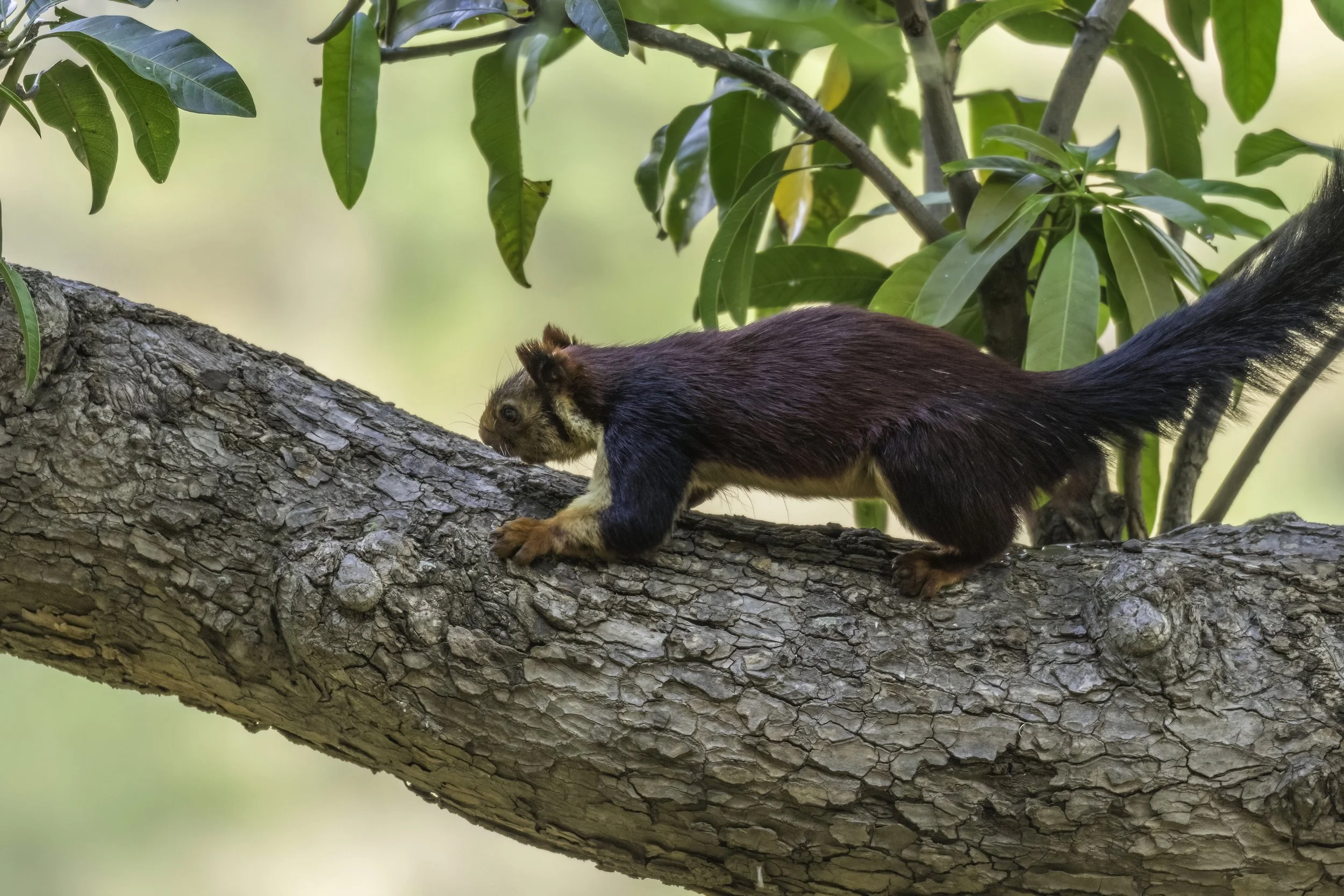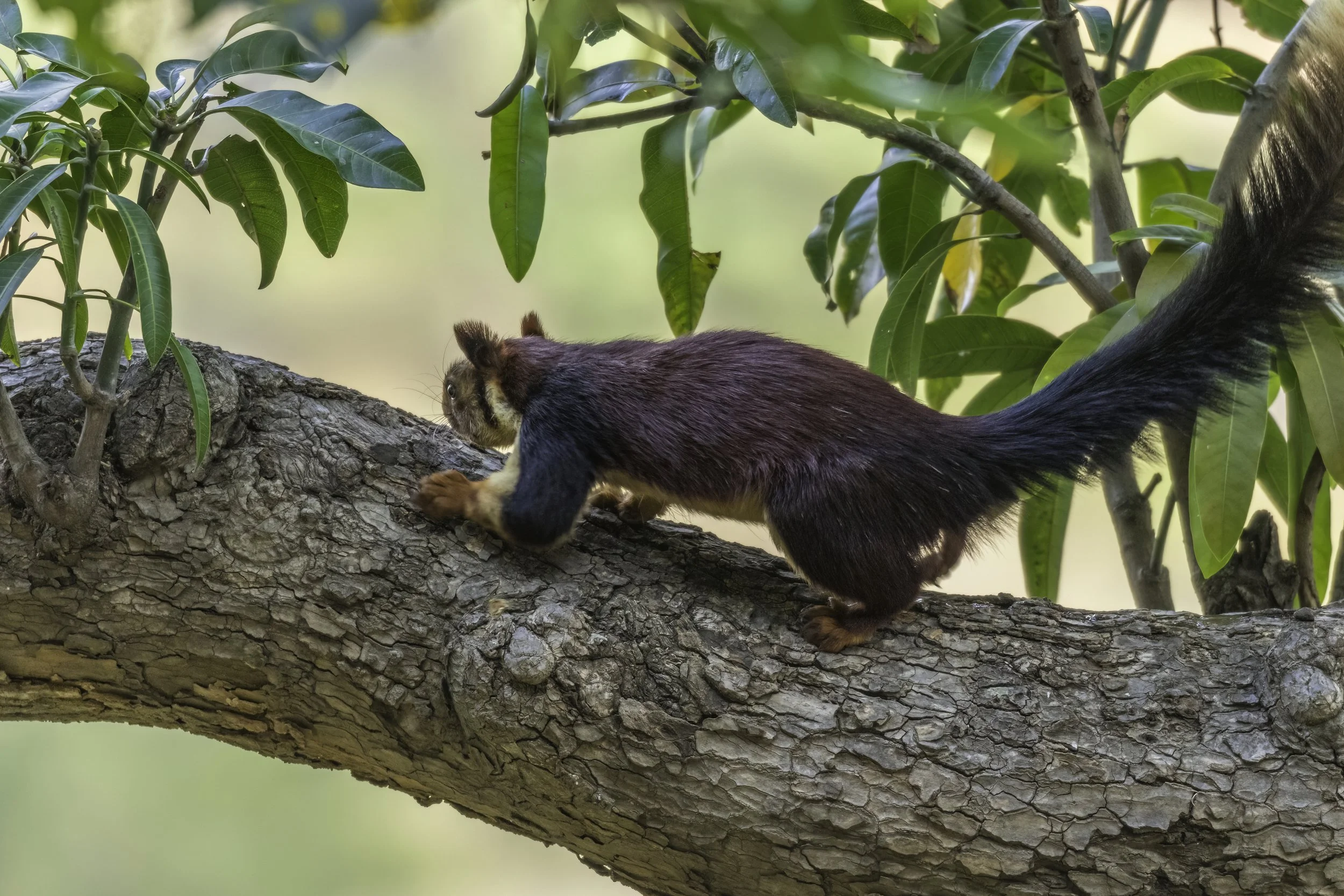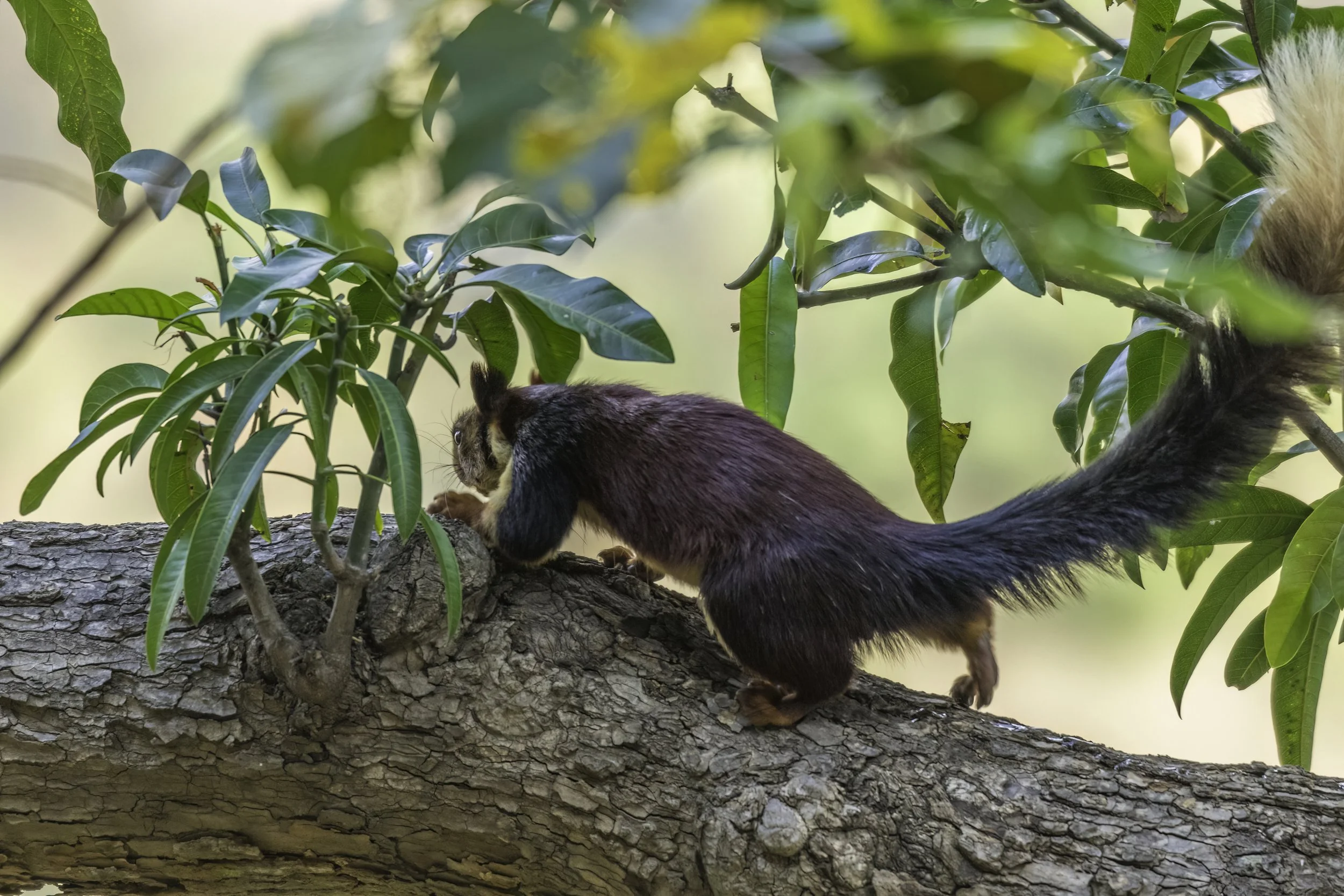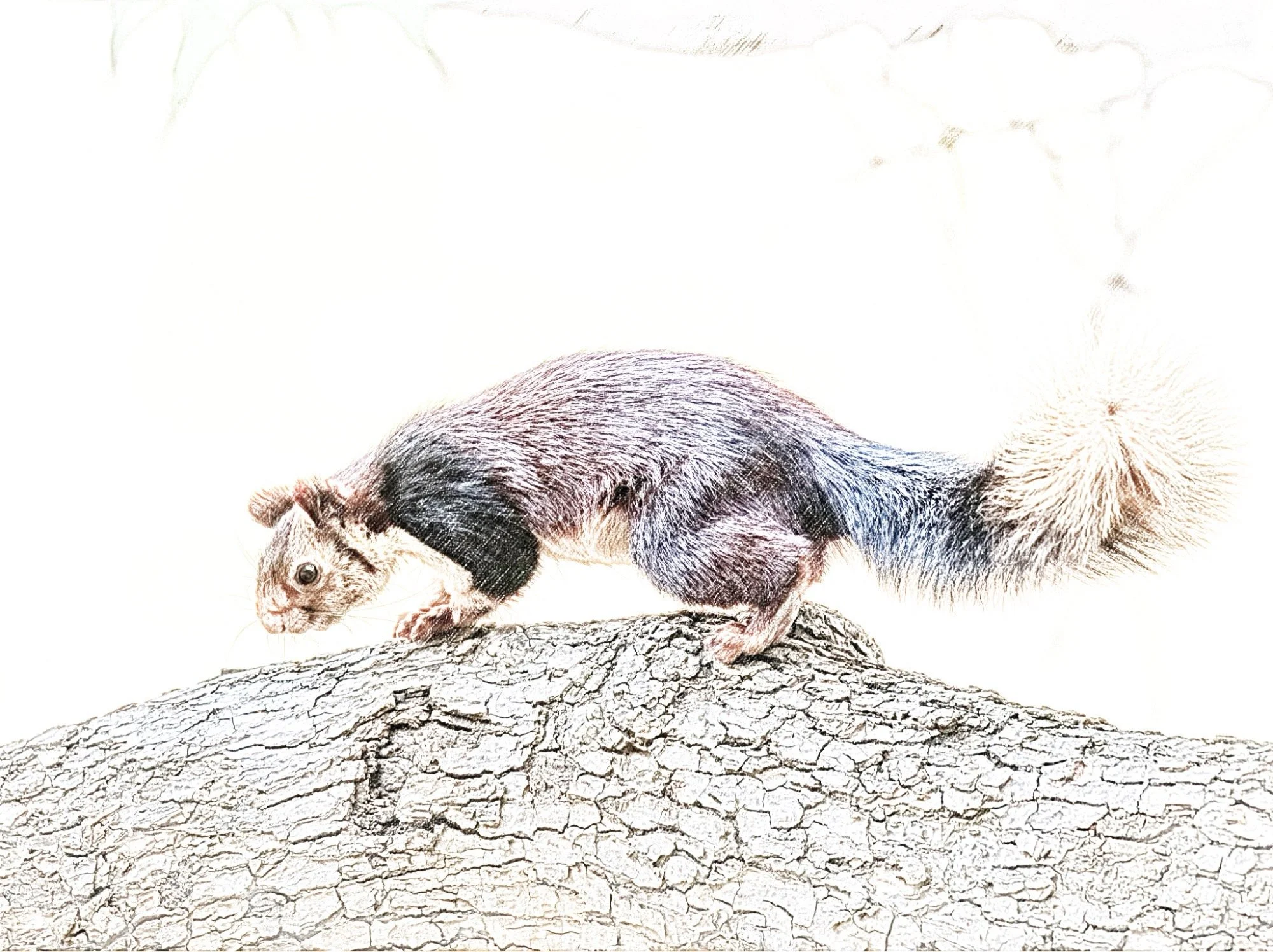Malabar Giant Squirrel
Ratufa indica
Uma Maheshwaram Temple Complex, Telangana; the Ghats of Panchgani, Maharashtra; Kabini, Karnataka; Pench, Madhya Pradesh
India, with its vast and diverse ecosystems, is home to an incredible variety of wildlife. Among the most captivating of these creatures are the giant squirrels. These remarkable rodents, known for their vibrant colours and impressive size, are not just a marvel of nature but also play a crucial role in the forest ecosystems they inhabit. The word squirrel has its origins in the Greek word skiouros which stands for ‘bushy tails’. Giant squirrels take their titles seriously - while the ubiquitous Indian Palm Squirrel weighs about 100 grams, giant squirrels weigh well over a kilogram or more! India is home to the Indian Giant Squirrel, the Black Giant Squirrel and the Grizzled Giant Squirrel. While they share several attributes with their other squirrel counterparts, they are also unique in their own way, size notwithstanding.
The Indian Giant Squirrel, also known as the Malabar Giant Squirrel, is perhaps the most well-known among its relatives. This magnificent creature can grow up to 3 feet long, with its bushy tail accounting for about half of its length. What truly sets the Indian Giant Squirrel apart is its stunning coat, which can range in color from deep maroon to a mix of black, brown, and orange. This vibrant coloration not only makes it one of the most striking animals in the forest but also serves as excellent camouflage among the dense foliage, helping it blend seamlessly into its surroundings.
Telangana is a state in southern India with Hyderabad as its capital. Hyderabad is home to the Charminar, a 16th-century mosque with 4 arches supporting 4 towering minarets. The monument overlooks the city's long-running Laad Bazaar. Laad Bazaar or Choodi Bazaar is a very old market popular for bangles located on one of the four main roads that branch out from the historic Charminar. Laad meaning lacquer is used to make bangles, on which artificial diamonds are studded. In this 1 kilometer-long shopping strip, most of the shops sell bangles, sarees, wedding related items, and imitation jewellery. Once the seat of the Qutb Shahi dynasty, the sprawling Golconda Fort is a former diamond-trading center.
Located in the central stretch of the Deccan Plateau, Telangana has sub-tropical climate and the terrain consists mostly of hills, mountain ranges, and thick dense forests covering an area of 27,292 km². The annual rainfall ranges between 1,100 mm to 1,200 mm and the annual temperature varies from 15 C to 45 C. The State is drained by a number of rivers which include Godavari and Krishna.
Telangana is endowed with rich diversity of flora and fauna. It has dense teak forests on the northern part along the banks of river Godavari. As per the Champion & Seth Classification of Forest Types (1968), the forests in Telangana belong to three Forest Type Groups, which are further divided into 12 Forest Types. The State Government has taken up a massive greening programme, 'Telangana Ku Harita Haram' in the State to plant and protect 230 crore seedlings over a period of 4 years. This initiative aims at achieving the twin objectives of increasing the forest cover and reduce pressure on the existing forest resources, through massive community participation by Vana Samrakshna Samithis (VSS) and Eco-Development Committees (EDCs) in Protected Areas and Watershed Development Committees in the Watershed areas. Recorded Forest Area (RFA) in the State is 26,904 km² of which 20,353 km² is Reserved Forest, 5,939 km² is Protected Forest and 612 km² is Unclassed Forests. In Telangana, during the period 1st January 2015 to 5th February 2019, a total of 9,420 hectares of forest land was diverted for non-forestry purposes under the Forest Conservation Act, 1980 (MoEF & CC, 2019). As per the information received from the State during that last two years, 12,730 ha of plantations including avenue plantations in the State.
Three National Parks and nine Wildlife Sanctuaries, which include the Amrabad Tiger Reserve, Kawal Tiger Reserve, Pocharam Wildlife Sanctuary, Etunagaram Wildlife Sanctuary, Kinnerasani Wildlife Sanctuary, Manjira Wildlife Sanctuary and Pakhal Wildlife Sanctuary, constitute the Protected Area network of the State covering 5.08% of its geographical area.
Nallamala Hills & forest range
The Nallamala Hills and forest range is a significant geographical feature within the Eastern Ghats of southern India, located in Telangana and stretching into Andhra Pradesh. This ~430 km long range, parallel to the Coromandel Coast, features rugged hills and deep valleys and hosts one of the largest contiguous forest areas in the region, encompassing a significant portion of the Nagarjuna Sagar Srisailam Tiger Reserve. The rugged, sparsely populated hills are composed for the most part of jumbled quartzites and slates and exemplify the mountain scenery of the Eastern Ghats. The range is known for its rich biodiversity, eco-tourism opportunities, and important religious sites like the Srisailam temple. It is bounded by the Krishna River to the north and the Pennar River to the south. The region includes important religious sites like the Srisailam Temple, one of the twelve Jyotirlingas. The Nallamala region has faced threats from proposed uranium mining projects, which would jeopardize the Tiger Reserve and the Chenchu's traditional way of life. Organisations like HYTICOS and local tribes have actively campaigned against these projects to protect the delicate ecosystem.
In the Nallamalla Hills and forest range the predominant vegetation is dry deciduous forest, with species such as Terminalia (తెల్ల మద్ది, అర్జున, ఎర్రమద్ది), Hardwickia (ఏపీ, నరేపీ), and Pterocarpus (ఏగిస, పెద్దగి and ఎర్ర చందనం). The forest also has a variety of medicinal plants. The forest is home to various mammals like Tigers, Leopards, Sloth Bears, Wild Boar, Sambhar, Blackbucks, and Pangolins. A variety of birds, including rare and migratory species, inhabit the sanctuary. Read about some of the species here. It is also host to diverse reptile species, including the King Cobra and Indian Rock Python and the forest is known for unique spider species like the critically endangered Gooty Sapphire Ornamental Tarantula (Poecilotheria metallica). The Chenchus, a forest-dwelling tribe, are the indigenous inhabitants of the Nallamala forest. They traditionally live a semi-nomadic, hunter-gatherer lifestyle and have remained largely cut off from modern society. The Chenchus have a unique, symbiotic relationship with the forest and play a key role in its conservation.
Uma Maheshwaram is the northern gateway to Srisailam — one of the jyotirlingas, on a hill surrounded by high trees. The Uma Maheshwaram temple is dedicated to the Hindu god Shiva located in the Nallamala Forest around 100 km from Hyderabad on the Hyderabad-Srisailam highway, about 4 kms from the village of Rangapur, Achampet. Nearby hills shield the temple and the 500-metre stretch to PapaNasanam (a mysterious spring of unknown source from which water can be drawn continuously through the year) from sunlight for most of the day, maintaining a temperature lower than the surroundings during the entire year. The area abounds in flora and fauna like the beautiful and Vulnerable Yellow-throated Bulbul.
‡‡‡‡‡
For a print of the beautiful wildlife from my various sojourns click on the button below to read my process and order a limited edition canvas from the catalog.
Malabar Giant Squirrel
Giant Squirrels are members of the genus Ratufa. Like other members of the squirrel family, they also have the characteristic prominent incisors that aid them in feeding on large fruits and rough surfaces like barks. The members of this genus prefer forest areas with well-branched trees that they can use to build nests. While the Indian Giant Squirrel resides within evergreen and semi-evergreen forests, the Black Giant Squirrel prefers montane evergreen and dry deciduous forests, and the Grizzled Giant Squirrel resides in montane forests in riverine ecosystems. Among the three species, the Grizzled Giant Squirrel and Black Giant Squirrel are designated as Near Threatened on the IUCN Red List. Although the Indian Giant Squirrel is designated as Least Concern, its population too is fast decreasing. Due to their increased dependence on forest areas, the conversion of forest land for agriculture and developmental activities such as linear intrusion projects are significantly affecting populations across all three species. Habitat loss is also forcing the Grizzled Giant Squirrel to forage for food in farmlands, earning them the title of agricultural pests. They are killed by farmers to reduce crop damage, thus further reducing local populations.
The Indian Giant Squirrel (Ratufa indica) is a large arboreal rodent endemic to India’s forests. The Malabar Giant Squirrel (Ratufa indica maxima/malabarica) is a subspecies of the Indian Giant Squirrel, a mammal endemic to the forests of India. This subspecies can be found throughout Kerala and a few southern locations in southern Karnataka. Its cousin subspecies range in Karnataka, Andhra Pradesh, Telangana, Maharashtra, Madhya Pradesh and Odisha and Jharkhand. One of the three giant squirrel species found in the country, the Malabar Giant Squirrel is characterised by its rufous-brown/purple colour and its ability to quickly jump from one tree to another. This animal is of the genus Ratufa, characterised by enlarged incisors which it uses to nibble on fruits, nuts and flowers. Their forelimbs grip their food and roll them around while their teeth bite chunks out of it. They can be seen either hanging down from the canopy, flat against the tree trunk, or scuttling about the branches, their tails bobbing as they do so. These squirrels are crucial seed dispersal agents for several tree species. It is intriguing to think that such a small animal plays such an important role, without which the forest wouldn’t exist. It’s humbling to see such a small animal shouldering such a huge responsibility.
Amongst squirrels, these are the heaviest in India, and can weigh up to 2 kilograms. There is much geographical variation in its colour forms, and several races /sub-species are recognized. It is active in the daytime, retiring to its nest at dusk. Squirrel nests – built of twigs and leafy branches – are called dreys. A giant squirrel makes many such nests in its home range, and could have up to 8 or 9 nests simultaneously. These are mainly for sleeping in, and are changed periodically. It’s easy to figure out which nest is active, based on the freshness of the leaves and the tightness of the structure. Old, inactive nests are brown and loosely held together, which may be repaired and re-used. They are careful to source their building material from elsewhere, and would never tear leafy branches from the tree on which they were building the nest. I had once seen the inside of a fallen nest, and it was lined with soft, cottony balls of the Silk Cotton tree. While all squirrels use and build nests to sleep in, giant squirrels also have special ‘nursery’ nests, where the mother gives birth to pups which share the nest with the mother until they become independent. The Malabar Giant Squirrel is one of the largest squirrels, with a head–and–body length of 25–50 cm, a tail that is about the same or somewhat longer, and a weight of 1.5–2 kg, although rarely up to 3 kg. The average for both sexes is about 36 cm in head–and–body length, 45 cm in tail length and weighing between 1.7–1.8 kg. It has a conspicuous one-, two-, or three-toned colour scheme. The colours involved can be whitish, creamy-beige, buff, tan, rust, reddish-maroon, brown, dark seal brown, or black. The underparts and the front legs are usually cream coloured, and the head can be brown or beige, and there is a distinctive white spot between the ears. Otherwise the colours depend on the subspecies.
Ten subspecies have been described, but recent authorities generally recognise four:
Ratufa indica indica: Found in the northern and central Western Ghats from around Mumbai to Karnataka. Its upper parts and basal half of the tail are rich reddish-maroon or reddish-brown; the distal part of the tail is whitish or buff. On occasion there can be some black at the shoulder or at the very base of the tail (features typically associated with other subspecies). A few other subspecies have been described within its range based on variations in size, overall colour hue and width of the pale tail-tip, but recent authorities generally regard them as synonyms of Ratufa indica indica.
Ratufa indica centralis: From central and eastern India, notably in the Satpura Range and Eastern Ghats (all other subspecies are from the Western Ghats region). It is relatively small and further differs from Ratufa indica indica by its black shoulder region, black tail except for the pale tip, and sometimes black rump.
Ratufa indica dealbata: Found in southern Gujarat (far northern Western Ghats region), but recent surveys have failed to locate it, and it is possibly extinct. A highly distinctive pale subspecies that is overall creamy-buff with a whitish tail and brown ears. It should not be confused with true albinos, rarely recorded in the Indian giant squirrel, which are whiter and have pink eyes unlike Ratufa indica dealbata.
Ratufa indica maxima: From southern Western Ghats. It resembles a large Ratufa indica centralis, but with more extensive black in the shoulder region and on the rump, and an almost entirely black tail (no pale tip). There is often a black dorsal stripe connecting the black shoulder region and rump. Another subspecies, Ratufa indica bengalensis, has been described from southern Karnataka and northern Kerala, in between Ratufa indica indica and Ratufa indica maxima. It generally resembles Ratufa indica indica, but the tail is black except for its pale tip and sometimes it has black shoulders, thus approaching Ratufa indica maxima or Ratufa indica centralis. Its intermediate appearance and distribution has caused some questions about its validity; it could be regarded as an intergrade and recent authorities often treat it as a synonym of R. i. maxima.
The Indian Giant Squirrel is predominantly found in the Western Ghats, Eastern Ghats and Satpura Range as far north as Madhya Pradesh (approximately 22° N). It is found at altitudes of 180–2,300 m (590–7,550 ft) in tropical deciduous, semi-deciduous (where often utilizing denser riparian growth), and moist evergreen forests and woodlands. In general, its distribution is fragmented because it is said to be intolerant of habitat degradation. The Indian Giant Squirrel generally nests in taller trees with a mean height of 36 ft (±10 ft SD) in order to avoid predators. It inhabits dense tropical rainforests, where it spends most of its time in the upper canopy, leaping from tree to tree with incredible agility. These squirrels prefer areas with tall, mature trees, which provide them with ample cover and food sources. Their range extends across several protected areas, ensuring that they have safe habitats, although habitat fragmentation still poses a significant threat.
These giant squirrels are up at the crack of dawn to start foraging within their ranges, which are usually around 1 to 2 hectares. Often, I would start from home early to find and observe them - usually by around 5-6 am - or while still dark wherever possible. Similarly during the evenings too. Till date, my experience with them in Panchgani was the easiest because they were resident where I was staying and quite easy to track. With most wild species, it is impossible to tell individuals apart unless they are marked or tagged. But with giant squirrels, there are ways to identify most individuals, as they often have an ear cut or bent due to territorial fights, or some differences in facial markings, or some quirky colouration / patterns of their long, bushy tails. This reminds me of the another beautiful animal similarly marked - the stunning, Endangered and reclusive Red Panda. Malabar Giant Squirrels are thought to be purely solitary animals but I’ve even seen groups of four-five all foraging together and apart from the odd squabble, they seem perfectly tolerant of each other.
The following video I made about 4 years back in Kabini where I recorded some behavioural aspects of the Malabar Giant Squirrel. The squirrel sequence starts at 2:27.
Tips for Spotting Malabar Giant Squirrels:
Be an early riser: Start your observation around 5-6 AM to catch them at the beginning of their foraging day.
Look in the late afternoon: This is something I noticed at Panchgani where these giants were active again before darkness set in. The owner also vouched for this behaviour.
Listen for their calls: Malabar Giant Squirrels are known for their distinctive, loud calls, which alert you to their presence.
Be patient and still: They are shy and solitary and are best observed from a distance without making any noise or sudden movements, as both noise and movement will scare them away.
Look for their habitat: They are arboreal, meaning they live in trees, so be sure to look up into the upper canopy of tall, well-branched trees in forested areas.
The Malabar Giant Squirrel is a shy and mostly solitary creature but can have overlapping ranges with other individuals. There would be different kinds of interactions amongst squirrels, depending on the sex and age/status of the neighboring animals. Many preferred resources were rare, and the spatial and temporal variation in food supply results in overlaps between individuals at locally abundant food resources. Since the defense of an exclusive area guaranteed of resources perennially is not possible, encounters were often avoided by spatial time-sharing. When encounters did occur, there would be aggressive territorial chases. But at super-abundant food resources, it was a common sight to see up to four individuals feeding at the same time. Here at the Uma Maheshwaram temple given the abundance of food, I soon realized that they maintained some distance (5-10 m) from each other and foraged in their own space, and only if any individual came close would there be a chase. This tolerance could be also related to some dominance hierarchies that existed. But when they do fight, it is an adrenaline-pumping experience. They scamper through the canopy at frightening speeds, with the chaser biting curiously at the runner’s tail. When they reach the edge of a branch, the fleeing squirrel propels itself into the air, soaring for several metres before finally grabbing hold of the adjacent tree. It is a few seconds of tense, squirrelly anticipation that is breathtaking to watch.
Giant squirrels are believed to be completely arboreal and need canopy continuity in their habitats. However, there have been times when these giant squirrels have come down to the ground to cross small stretches where they had no canopy. This is a clear indication of how these squirrels are adapting to their ever changing habitat and this also includes their diet. This species is primarily herbivorous, feeding on a wide variety of fruits, nuts, flowers, and bark. They are also known to occasionally consume insects, especially during times of food scarcity. Its loud, distinctive call can often be heard echoing through the forest. These calls serve as a form of communication between individuals, especially during mating season or when alerting others of potential danger. Some sources say they also make a particular whistling sound, but I am yet to hear it.
Almost all species of giant squirrels face various threats, primarily due to habitat loss caused by deforestation and human encroachment. The Indian Giant Squirrel is currently listed as Least Concern by the IUCN, but its populations are declining in some areas due to habitat fragmentation. Conservation efforts are underway to protect these incredible creatures. Sanctuaries like the Srivilliputhur Grizzled Squirrel Wildlife Sanctuary in Tamil Nadu and protected areas in the Western Ghats and Northeastern India play a crucial role in preserving their habitats. Initiatives such as habitat restoration, anti-poaching measures, and community engagement are critical in ensuring the long-term survival of these species.
In 2020, the Zoological Survey of India conducted a first-of-its-kind survey of the Malayan or the Black Giant squirrel in the country. Squirrel numbers are intrinsic indicators of forest health and the study found that by 2050, India could lose about 90 per cent of its Malayan Giant Squirrel population, pushing the species to the brink of widespread extinction. Additionally, the study also highlights the lacunae in our understanding of squirrel populations and the threats they face. A more niche study of Indian Giant Squirrels in the Karlapat Wildlife Sanctuary, Odisha, revealed that current practices in the sanctuary cause damage to the nesting sites of the squirrels and impact their food sources. It is critical that we devise specific conservation measures for the giant squirrels in the country, if we are to see them galloping through our forests without a worry!
In a world where tigers and elephants get all the attention, I find it imperative to showcase these so-called lesser animals. They are equally fascinating. I hope that, by giving them the spotlight, they will receive the same admiration. The giant squirrels of India are not just icons of the country’s natural heritage but also vital components of the forest ecosystems. Their presence indicates the health of the forests, and their protection is integral to preserving the biodiversity of these regions. By safeguarding the habitats of these magnificent squirrels, we not only protect them but also the countless other species that share their homes. The survival of these colorfull aerial acrobats is intertwined with the future of the forests they inhabit, making their conservation a priority for all who cherish the natural world. So, the next time you venture into the forests of India, keep an eye out for these colorful aerial acrobats. Spotting one is a true testament to the wonders of nature that India has to offer.
‡‡‡‡‡
Related Posts

